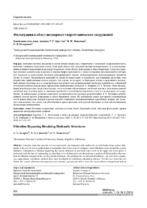Фильтрация в обход подпорных гидротехнических сооружений

Date
2020Publisher
Another Title
Filtration Bypassing Retaining Hydraulic Structures
Bibliographic entry
Круглов, Г. Г. Фильтрация в обход подпорных гидротехнических сооружений = Filtration Bypassing Retaining Hydraulic Structures / Г. Г. Круглов, Н. Н. Линкевич, О. В. Немеровец // Наука и техника. – 2020. – № 3. – С. 252-257.
Abstract
Бетонные плотины, входящие в состав речных гидроузлов, сопрягаются с земляными сооружениями или с берегами с помощью береговых устоев. Если грунт берега или земляной плотины водопроницаем, то в зоне примыкания возникает фильтрация воды вокруг берегового устоя. Расчет фильтрации в обход берегового устоя при заданных отметках уровней воды в верхнем и нижнем бьефах выполняется с целью построения опоясывающей устой кривой депрессии и определения градиента фильтрационного потока, контролирующего фильтрационную прочность грунта за устоем. Теоретических решений эта задача не имеет ввиду ее сложности, для отдельных расчетных схем разработаны приближенные методы расчета. Для случая, когда грунт за береговым устоем однородный и изотропный, приток грунтовых вод со стороны берега отсутствует или незначительный (им можно пренебречь), а береговой устой располагается на водоупоре, предложены приближенные методы В. П. Недриги и Р. Р. Чугаева. Опыт обследования ряда белорусских гидроузлов показал, что отсутствие обоснованного расчетами прогноза положения уровней грунтовых вод за устьем ведет к снижению прочности и устойчивости берегового устоя и к возможному его разрушению. В лабораторных условиях выполнена экспериментальная проверка разработанного Р. Р. Чугаевым приближенного метода расчета фильтрации в обход берегового устоя. По результатам опыта простроена опоясывающая устой кривая депрессии, которая показала хорошее совпадение экспериментальных и расчетных данных, что позволяет использовать этот метод для обоснованного проектирования конструкций береговых устоев, обеспечивающих их надежную эксплуатацию.
Abstract in another language
Concrete dams that are part of river waterworks are integrated with earthworks or with banks using coastal abutments. If the soil of cost or earthen dam is permeable, then in the zone of contiguity water filtration occurs around the coastal abutment. Calculation of filtration bypassing the coastal abutment at specified water levels in the upper and lower pools is performed with the aim of constructing an encircling curve of depression and determining a gradient of filtration flow that controls the filtration strength of the soil beyond the abutment. This problem has no theoretical solutions – in view of its complexity, approximate calculation methods have been developed for individual calculation schemes. For the case when the soil behind the coastal abutment is homogeneous and isotropic, groundwater inflow from the coast is absent or insignificant and canbe neglected, and the coastal abutment is located on a water bed and approximate methods by V. P. Nedrigi and R. R. Chugaeva are proposed in the paper. The experience of surveying a number of Belarusian hydropower stations has shown that the absence of a justified prediction pertaining to the position of groundwater levels beyond the estuary leads to a decrease in the strength and stability of the coastal abutment and its possible destruction. An experimental verification of the approximate method for calculation filtration bypassing the coastal abutment developed by R. R. Chugaev has been carried out in laboratory conditions. According to the obtained experience a depression curve encircling the abutment has been constructed which show good agreement between experimental and calculated data that allows to use this method for reasonable design of coastal abutment structures ensuring their reliable operation.
View/
Collections
- № 3[9]
